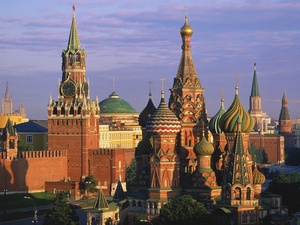
The system built to manage Russia’s nuclear legacy is crumbling, our new report shows
Our op-ed originally appeared in The Moscow Times. For more than three decades, Russia has been burdened with the remains of the Soviet ...
News

Publish date: March 27, 2020
News
After years of international pressure and increasing internal anxieties, fossil fuel-rich Russia for the first time set out a long-term, low carbon development plan for the coming three decades earlier this week.
Under the plan, Russia would pledge to cut greenhouse gas emissions by a third by 2030 from 1990 levels – the year the heavily industrialized Soviet Union collapsed – though that would represent an increase in Russia’s greenhouse gas emissions from today.
Experts have criticized the plan, saying that the strategy it outlines and the targets it sets for 2030 are not ambitious enough. But they did say that it signaled a growing interest among Russia’s business and political elites in tackling climate change in an economy that relies heavily on supplying oil, gas and coal.
In the draft plan released Monday, which stretches up to 2050, Russia’s Ministry of Economic Development projected that emissions would rise to the equivalent of 2.08 billion tons of carbon dioxide by 2030, including land use and forestry, or 67 percent of 3.11 billion tons recorded in 1990.
The draft document outlines four main scenarios – deemed “inert,” “basic,” “intensive,” and “no government support.”
Under the basic scenario, which the ministry said was most feasible, 2030 emissions levels would be up from 1.58 billion tons in 2017, or 51 percent of 1990 levels.
By 2050, that basic scenario projects that emissions would dip to 1.99 billion tons, or 64 percent of 1990 levels.
All told, Russia would not become carbon neutral until much later in this century.
Still, the 2030 goal spelled out by the draft is more ambitious than Russia’s existing target to limit 2030 emissions to 75 percent of 1990 levels – or 2.33 billion tons – which Moscow submitted as its contribution to the 2015 Paris climate agreement.
The draft now goes to other ministries and business associations for review before it is submitted to President Vladimir Putin for approval.
“This strategy draft is the first comprehensive attempt of the federal government to look into Russia’s economic development trajectory toward 2050 climate goals,” Mikhail Rasstrigin, Russia’s deputy minister of economic development, told Reuters.
“Importantly, it sets specific goals for the key areas where the bulk of energy efficiency effects could be reaped,” he added. According to the plan, those areas are industry, buildings, energy generation and transport.
Under the draft, Russia would seek to reduce demand for fossil fuels and boost renewable energy. It would also upgrade insulation for buildings and encourage energy efficiency from petrochemicals to agriculture, it said. It also outlined some benefits from global warming, such as greater access to shipping routes via the Northern Sea Route in Russia’s Arctic north.
All countries are under pressure to announce more ambitious policies on climate change in 2020, the first five-year milestone of the Paris climate agreement – with calls to link stimulus packages to combat the coronavirus to a greener economy. But so far, the United Nations says only 15 countries have submitted long-term, low-emissions strategies under the 2015 agreement.
Russia, the world’s fifth-largest emitter of greenhouse gases, after China, the United States, the EU and India, did not officially join the Paris Agreement until September 2019.
The new 2030 emissions targets outlined in the draft will be announced as part of Russia’s updated climate action plant, which will be submitted to the United Nations later this year, Reuters reported.
The represent a slight increase in ambition over Russia’s previous goal of a 25 percent emissions cut to a 30 percent cut. While the plan’s basic scenario won’t reach carbon neutrality by 2050, emissions are forecast to begin declining after 2030 – reaching 36 percent below 1990 levels at the midcentury mark.
If the government opts for an “intensive” approach, however, emissions could be cut by 48 percent by 2050, with Russia becoming carbon-neutral late this century, the plan noted.
“This is not an ambitious plan … it would allow emissions to rise,” Niklas Höhne, founding partner of the New Climate Institute, told Climate Home News.
“It’s not in line with the Paris Agreement. Countries need to go for the highest possible ambition,” he said.
Alexey Kokorin of environmental group WWF Russia told Reuters that climate experts would likely criticize the strategy – but he said that the plan “honestly and openly speaks about problems in Russia, including inertia of its economy, (which is) highly dependent on fossil fuels.”
In an interview with the RBC Russian newswire, Kokorin said that even if even if Russia sticks only to the basic plan for now, it is likely to set more ambitious climate targets in the future.
Deputy minister Rasstrigin said the low-carbon plan would stimulate debate in political and business circles on the “need to transform both the structure of investments and the structure of Russia’s economy to ensure robust growth potential.”

Our op-ed originally appeared in The Moscow Times. For more than three decades, Russia has been burdened with the remains of the Soviet ...

The United Nation’s COP30 global climate negotiations in Belém, Brazil ended this weekend with a watered-down resolution that failed to halt deforest...

For more than a week now — beginning September 23 — the Zaporizhzhia Nuclear Power Plant (ZNPP) has remained disconnected from Ukraine’s national pow...

Bellona has taken part in preparing the The World Nuclear Industry Status Report 2025 and will participate in the report’s global launch in Rome on September 22nd.